 For
a full overview click here
For
a full overview click here
 For
a full overview click here For
a full overview click here
Hampshire seaports sundial trail |
|---|
The dials of Southampton, Gosport and Portsmouth, Hampshire
This trail lasts about a day, and involves walking and travelling by car and ferry. Start in Southampton on a sunny Saturday. One of the car parks by the Civic Centre is as good a place as any in which to park. Just opposite the clock tower (a carillon) at the Civic Centre is a modern equatorial dial, opened June 23rd 1995. Made by Peter Parkinson, and commissioned by BBC South and Hampshire County Council on association with The Hampshire Sculpture Trust, it is best seen in the morning as the building itself shadows the dial in the afternoon. 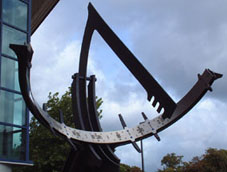 Walk straight down into Southampton
towards the West Quay shopping centre. After a while, on your left you
will see the old walls of Southampton and some modern brick built homes
inside them. There are two sundials dated 1982 to find here. The easiest
one to find is in Blue Anchor Lane, near the Tudor House Museum. The child's
pointer on the map of the Southampton Walls indicates it. Walk straight down into Southampton
towards the West Quay shopping centre. After a while, on your left you
will see the old walls of Southampton and some modern brick built homes
inside them. There are two sundials dated 1982 to find here. The easiest
one to find is in Blue Anchor Lane, near the Tudor House Museum. The child's
pointer on the map of the Southampton Walls indicates it.  The
dials are modern ones, and it looks as if they are made from a resin compound.
They are vertical south dials, and the brick architecture around them
is reminiscent of portholes, reflecting Southampton's maritime past. If
you have time, visit the Tudor house museum that has, from time to time,
displayed a horizontal dial inside. St Michael's Church (1066-76) is also
worth visiting: it contains an interesting font of Tournai marble (1170),
one of four in Hampshire. Outside it A. R. Green recorded a scratch dial
in 1942, but recent searching has not found it. The
dials are modern ones, and it looks as if they are made from a resin compound.
They are vertical south dials, and the brick architecture around them
is reminiscent of portholes, reflecting Southampton's maritime past. If
you have time, visit the Tudor house museum that has, from time to time,
displayed a horizontal dial inside. St Michael's Church (1066-76) is also
worth visiting: it contains an interesting font of Tournai marble (1170),
one of four in Hampshire. Outside it A. R. Green recorded a scratch dial
in 1942, but recent searching has not found it. 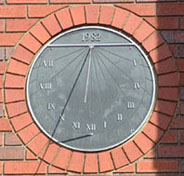 The
sister dial to the Blue Anchor lane dial lies a bit further to the north
in Biddlesgate Court. Walk north along the walls, back to the Bargate
to see it. The
sister dial to the Blue Anchor lane dial lies a bit further to the north
in Biddlesgate Court. Walk north along the walls, back to the Bargate
to see it. 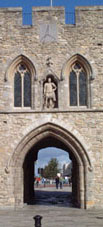 The
Bargate was the main entrance to the walled town of Southampton in the
12th century. The
Bargate was the main entrance to the walled town of Southampton in the
12th century. It is symbolic of Southampton, and the south face has a fine (though worn) vertical south declining (slightly to the west) dial erected in 1705. The initials I.T. can just be seen. They belong to John Thornburgh the Mayor at the time. Below is a statue of George III in Roman clothing. This dial has featured on many postcards of Southampton, and those dating from the early 1900's indicate that the hour lines were clearly painted in. Today, with no such care, it is difficult to tell the time. 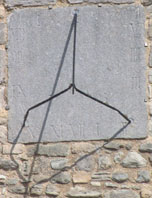 Passing
through the Bargate and heading north up High Street continue until you
come to the Cenotaph. In the park to the east is a pedestal, erected in
1902 to display a horizontal dial to mark the coronation of Edward VII.
Unfortunately the dial has disappeared, and I have been unable to find
a picture of it. The park makes a pleasant place to sit and eat a picnic. Passing
through the Bargate and heading north up High Street continue until you
come to the Cenotaph. In the park to the east is a pedestal, erected in
1902 to display a horizontal dial to mark the coronation of Edward VII.
Unfortunately the dial has disappeared, and I have been unable to find
a picture of it. The park makes a pleasant place to sit and eat a picnic.
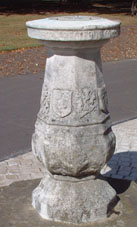 Go west now, through the park, back to the Civic Centre and your car.
Head out of Southampton for the M27, and go along this to junction 11
where you follow the signs for Gosport. Park in Gosport somewhere near
the ferry for Portsmouth. Walk up the main shopping street (there is a
street market on Saturdays) to the armillary sphere at the top, opposite
Burger King. The gnomon shows Henry of Blois, Bishop of Winchester, returning
safely to Gosport (God's Port) in 1144. The dial was designed by Joanna
Migdal and is adjusted for longitude. See BSS Bull 97.2 for full details.
Go west now, through the park, back to the Civic Centre and your car.
Head out of Southampton for the M27, and go along this to junction 11
where you follow the signs for Gosport. Park in Gosport somewhere near
the ferry for Portsmouth. Walk up the main shopping street (there is a
street market on Saturdays) to the armillary sphere at the top, opposite
Burger King. The gnomon shows Henry of Blois, Bishop of Winchester, returning
safely to Gosport (God's Port) in 1144. The dial was designed by Joanna
Migdal and is adjusted for longitude. See BSS Bull 97.2 for full details.
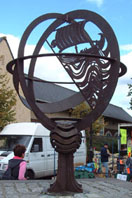 As
you go down the High Street look out for the mock armillaries on top of
the light towers. As
you go down the High Street look out for the mock armillaries on top of
the light towers. At the ferry turn right to walk along the promenade to the Millennium Time Space. This is an open space with a vertical mast on which is two cones. Near noon these cones onto a meridian line focus the sun, and the shadow of the cones indicates the time on a series of lines on the floor. >  Unfortunately
there is also a large digital clock that runs around the circumference
of the circular base, and it is easy to confuse the hour lines of the
clock with the hour lines of the sundial! The shadow of a large block
of flats also spoils the dial in the afternoon. You can see HMS Victory
and HMS Warrior on the other side of the water. Unfortunately
there is also a large digital clock that runs around the circumference
of the circular base, and it is easy to confuse the hour lines of the
clock with the hour lines of the sundial! The shadow of a large block
of flats also spoils the dial in the afternoon. You can see HMS Victory
and HMS Warrior on the other side of the water. Return to the ferry. You have a choice now of going round to Portsmouth by car, or crossing on the ferry. The ferry is £1.60 (adult return), quicker, and far more fun! However it does involve some walking the other side, but Gunwharf Quay is a modern (and interesting) area to explore, especially for those not too keen on sundials. On disembarking head roughly west towards the Cathedral in Old Portsmouth. This is in High Street, and this street is rich in history, as well as being home to a very unusual dial. Halfway up the street is the George Court, and in this area is a spherical dial. 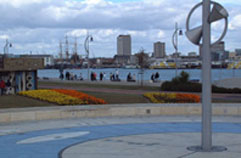 Although not marked with hours (the last painter must have painted them
out, as a picture taken in the 1960's shows the numerals) it still has
the iron arc pivoted at the poles that you move until the shadow of the
arc is beneath it. It has not been moved for some time, as the last painting
seems to have stuck it in one position!
Although not marked with hours (the last painter must have painted them
out, as a picture taken in the 1960's shows the numerals) it still has
the iron arc pivoted at the poles that you move until the shadow of the
arc is beneath it. It has not been moved for some time, as the last painting
seems to have stuck it in one position! 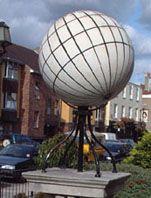 In the High Street is the church where John Pounds (1766-1839, Founder
of Ragged Schools) is buried; the house where George Villiers, Duke of
Buckingham, was assassinated on 23 August 1628, and Portsmouth Grammar
School as well as the Cathedral!
In the High Street is the church where John Pounds (1766-1839, Founder
of Ragged Schools) is buried; the house where George Villiers, Duke of
Buckingham, was assassinated on 23 August 1628, and Portsmouth Grammar
School as well as the Cathedral! Retrace your steps to the ferry and your car at Gosport, or go on your way. |